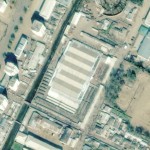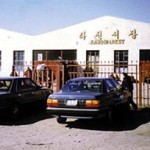Pictured above: (L) satellite image of the Rajin Market, (R) a ground-level photo taken in 1999
Among the the flurry of activities that comprised the DPRK’s recent public relations campaign in Rason (Rajin-Sonbong), the Rajin Market appeared on the itineraries of a few visiting delegates. Alexa Olsen writes about the market for the Associated Press:
Chinese travel agents, potential investors and foreign journalists recently traveled into the North to get a look at the special economic zone Pyongyang is promoting in Rason. It lies in the far northeastern tip of North Korea, 600 miles (1,000 kilometers) from Pyongyang, but will be about an hour’s drive from China once the road is completed.
Rumbling Chinese cargo trucks already ply the route, churning up plumes of choking dust and ferrying containers of Chinese-made shoes, plastic toys, computer speakers, T-shirts and DVDs to the Rason Free Trade Market.
The market, a 13-year-old experiment in small-scale capitalism, has been so successful that the Chinese managing company, the Tianyu Group, is planning to expand the jam-packed 54,000-square-foot (5,000-square-meter) market to 320,000 square feet (30,000 square meters), Tianyu vice director Zheng Zhexi said.
“As I see it, this is the way of economic development, and it’s something that the people want,” Zheng said. “I think it’s reached a point where it cannot be reversed.”
North Korea declared the area a special economic zone 20 years ago. But after a brief flurry of activity and funding from the U.N. Development Program, the project languished without backing from Pyongyang’s leadership.
…
Rason has benefited from the shift in Pyongyang’s priorities. When Zheng arrived in 1997 to set up the market, people were hesitant to get involved. Now Tianyu doesn’t have the space to approve even a fraction of the applications from prospective vendors, he said.
“Ordinary people’s sense and the awareness of the market, and their views on the economy — all these have changed a lot,” Zheng said.
Foreign journalists, who typically are barred from local markets, were taken on a strictly controlled, 15-minute tour. No photos, no notes, the guide instructed: “Just use your eyes.”
Vendors, mostly women, stood behind stands loaded with freshly skinned rabbit and live chickens, as well as goods mostly imported from China: blouses, speakers, refrigerators, sofas, shampoo, playing cards, binoculars.
High heels went for 25 yuan (US$4), a Kim Jong Il-style beige suit for 85 yuan ($13) and a container of sea salt for 3 yuan ($0.47).
North Korean tour guide Mun Ho Yong, 25, said his family shops at the market several times a week to supplement state rations of rice, oil and fish.
Everything Mun wore — striped dress shirt, belt, polyester trousers and black dress shoes — was bought at the market except his pin of late President Kim Il Sung attached to his shirt, over his heart.
One major challenge will be to successfully leap from the market’s small-scale commerce to full-fledged manufacturing and trade.
(UPDATE) In an article published later in the New York Times (2011-10-12):
A Chinese company critical to Rason’s development, the Yanbian Tianyu International Trade Company, got involved here 13 years ago. It began by erecting the bazaar, then built the casino, a hospital, a bread factory and a telecommunications building. It is now working on a cement factory, and operates two iron mines.
“The policy environment has been improving continuously,” said Zheng Zhexi, 58, the company’s vice president. “It’s moving towards a market economy.”
He pointed to the official tolerance for the bazaar, where merchants rent stalls from the government to sell goods that they buy from Chinese traders. Prices fluctuate and shoppers haggle. The bazaar has proved so successful that it is expanding to six times the current size.
These kinds of markets have sprung up all over the country to supplement the government’s weak food distribution system. Still, the government is sensitive to their capitalist nature, and some top officials have tried to set limits on them. Foreign journalists were permitted a 15-minute tour of the Rason market on the condition that they not photograph it or take notes.
The market, open just a few hours each day, was bustling, with goods like skinned rabbits, sofas, Sony headphones and Dell computer mice. A soldier with a Kalashnikov slung over his back walked among the aisles, looking to buy, and women running stalls wore red vests, the uniform of officially registered merchants.
In one corner was an office with the English words “Foreign Exchange” above the door. In Rason, currency is exchanged at the market rate — one Chinese renminbi to 350 North Korea won — rather than at the official rate, which values one renminbi at 15 won.
Additional Information:
1. Previous posts on Rason can be found here.
2. Additional information can be found here.
3. Source:
Tending a Small Patch of Capitalism
New York Times
Edward Wong
2011-10-12


